13 Most Sustainable Lifestyle Clothing Brands: The Conscious Consumer’s Guide
Impactful Ninja is reader-supported. When you buy through links on our site, we may earn an affiliate commission.
Learn more
Learn more
.
Hey fellow impactful ninja ? You may have noticed that Impactful Ninja is all about providing helpful information to make a positive impact on the world and society. And that we love to link back to where we found all the information for each of our posts. Most of these links are informational-based for you to check out their primary sources with one click. But some of these links are so-called "affiliate links" to products that we recommend. First and foremost, because we believe that they add value to you. For example, when we wrote a post about the environmental impact of long showers, we came across an EPA recommendation to use WaterSense showerheads. So we linked to where you can find them. Or, for many of our posts, we also link to our favorite books on that topic so that you can get a much more holistic overview than one single blog post could provide. And when there is an affiliate program for these products, we sign up for it. For example, as Amazon Associates, we earn from qualifying purchases. First, and most importantly, we still only recommend products that we believe add value for you. When you buy something through one of our affiliate links, we may earn a small commission - but at no additional costs to you. And when you buy something through a link that is not an affiliate link, we won’t receive any commission but we’ll still be happy to have helped you. When we find products that we believe add value to you and the seller has an affiliate program, we sign up for it. When you buy something through one of our affiliate links, we may earn a small commission (at no extra costs to you). And at this point in time, all money is reinvested in sharing the most helpful content with you. This includes all operating costs for running this site and the content creation itself. You may have noticed by the way Impactful Ninja is operated that money is not the driving factor behind it. It is a passion project of mine and I love to share helpful information with you to make a positive impact on the world and society. However, it's a project in that I invest a lot of time and also quite some money. Eventually, my dream is to one day turn this passion project into my full-time job and provide even more helpful information. But that's still a long time to go. Stay impactful,Affiliate Disclosure
Why do we add these product links?
What do these affiliate links mean for you?
What do these affiliate links mean for us?
What does this mean for me personally?
![]()
Amid growing concerns about the textile industry’s environmental impact, there is pressure to find greener clothes for your wardrobe, such as items that will better serve your lifestyle as well as the environment. Unfortunately, fashion greenwashing makes it harder for you and all other consumers to figure out which clothing brands offer the most eco-friendly garments. So, we had to ask: Which are the most sustainable lifestyle clothing brands?
The most sustainable lifestyle clothing brands are Patagonia, United by Blue, and Finisterre, which prioritize low-impact and high-performing materials while striving for circularity. In addition, VAUDE and Nisolo reduce carbon emissions and textile waste.
Whether you are searching for some perfectly fitting bike shorts or a weather-proof jacket to fit your chosen lifestyle without negatively impacting the soil, the water, the animals, and other people, there is a brand for you. So, let’s keep reading to learn more about the most sustainable lifestyle clothing brands and how they ensure sustainable, ethical practices.
Here’s How We Selected the Most Sustainable Lifestyle Clothing Brands
Lifestyle clothing brands cater to a particular lifestyle, often stemming from a certain interest or preference. For instance, they sell clothes and gear for people who frequent the beach for water activities, go up into the mountains for hiking, or want to opt out of animal-derived or synthetic products.
“Sustainable: The ability to be maintained at a certain rate or level | Avoidance of the depletion of natural resources in order to maintain an ecological balance”
Oxford Dictionary
The brands on this list were chosen based on their commitment and actions to promote sustainable practices while reducing the environmental impacts of the textile industry.
They are transparent about their materials, processes, and workforce management within their supply chain.
Some brands focus their efforts on reducing waste and optimizing natural resources while others strive to reduce the carbon footprint of their clothes.
All of these brands share the commitment to reshape the textile industry toward a more sustainable and Earth-friendly sector.
These Are the 13 Most Sustainable Active Clothing Brands
Most Sustainable Active Clothing Brands
Overall, these lifestyle clothing brands are sustainable. Yet, they take various approaches to reduce environmental impacts and uphold ethical standards. Let’s dive into each brand and find out more.
Patagonia: Everyday Wear for Those Who Care

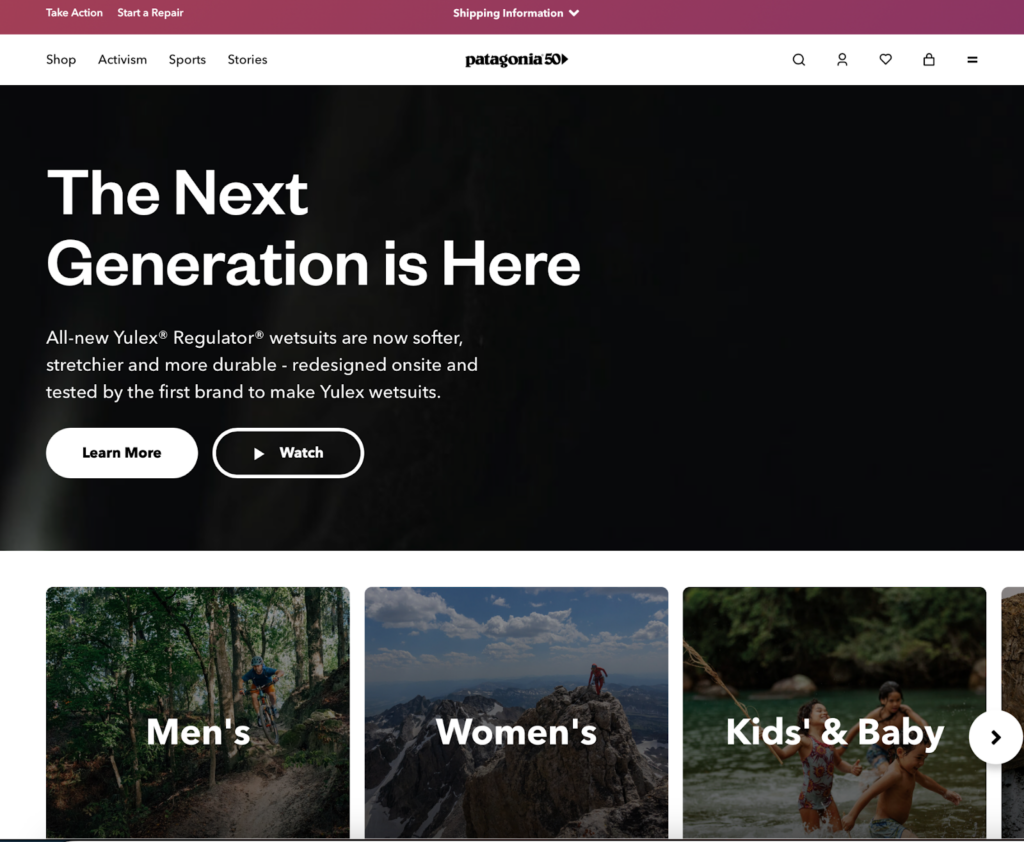
“Together, we can prioritize purpose over profit and protect this wondrous planet, our only home.”
Patagonia
🌎
How do they ensure their sustainability?
Patagonia puts sustainability at the center of their operation. They work to reduce, rather than simply offset, carbon emissions where it matters the most: in the supply chain and material manufacturing. They reduce their carbon footprint by removing high-impact virgin fossil-based fibers from their collections, using “Environmental Profit and Loss” to guide their production decision, and helping their suppliers to cut emissions. For example, Patagonia’s fall 2023 collection was made up mostly of preferred materials (91% by fabric weight), including Regenerative Organic Certified fibers, hemp, man-made cellulose fibers, recycled cotton, and recycled polyester. On top of that, Patagonia’s Worn Wear Program encourages customers to repair and recycle their products, extending the textile lifecycle and reducing waste. Lastly, Patagonia is certified as a B Corporation and a Bluesign® brand.
🌐
How do they ensure their ethics?
Patagonia commits to fair trade practices. Through the partnership with Fair Trade USA, they currently produce 86% of their clothes in 20 Fair Trade Certified™ factories. Patagonia pays a premium for every item produced in such factories, accumulating in a fund for workers to use in their chosen community projects, whether in healthcare or parent support or to withdraw as a cash bonus. Additionally, they have various social responsibility programs to prevent harm and create positive impacts on the lives of apparel workers in their supply chain. These include the Fair Labor Association, the Living Wage Program, the Migrant Workers Program, and the Responsible Purchasing Practices. Patagonia is also fully transparent about the locations of their facilities and suppliers.
🤝
Are they part of any giving-back programs?
Since 1985, Patagonia has pledged 1% of sales annually to environmental causes. They have awarded over $89 million in cash and kind donations to domestic and international grassroots environmental groups, making a difference in their local communities. In 2022, the founder of Patagonia gave away his family’s ownership of the company to the newly created Patagonia Purpose Trust and the not-for-profit organization Holdfast Collective, ensuring that all future profits from the company are used to fight the climate and extinction crisis.
🛍️
What is their product range?
- Best for: kidswear, menswear, womenswear
- Product range: shirts, pants, jackets, blazers, hoodies, sweatshirts, T-shirts, shorts, plus-size
- Price range: $$$
- Size range: XXS–XXXL
United by Blue: Backpack Brand That Designs Out Waste at Both Ends of the Life-Cycle

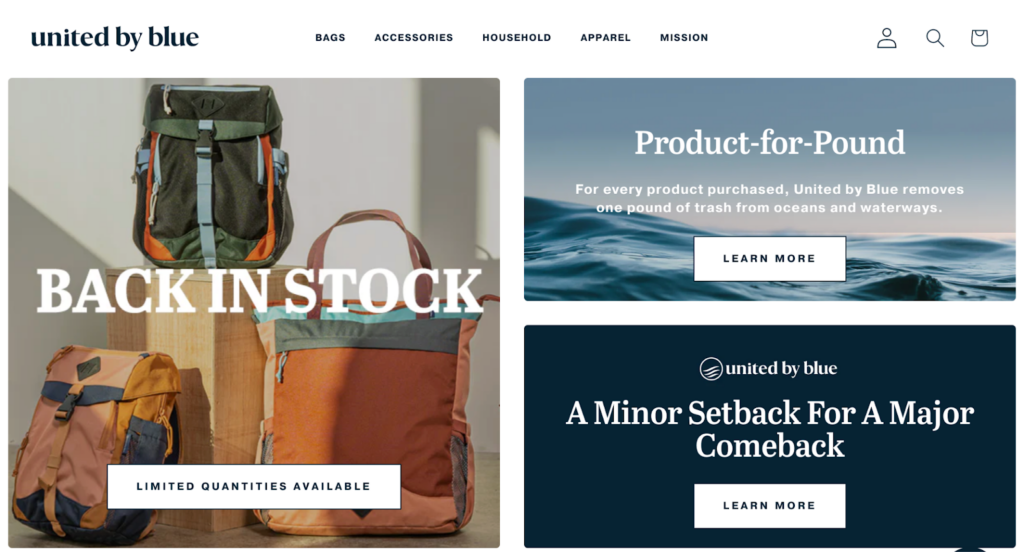
“Our hope is that through engaging cleanups, better business practices, and trash-cleaning products we can clean up the planet and the fashion industry one sustainable choice at a time. ”
United by Blue
🌎
How do they ensure their sustainability?
United by Blue ensures sustainability by designing out waste. In particular, they make durable products from sustainably sourced, low-impact materials. They also make them in factories with some of the highest social and environmental health certifications on a slow fashion timeline. Firstly, they source a high proportion of lower-impact materials. They prioritize biodegradable, regenerative fibers, recycled materials, and deadstock fabric. United by Blue’s products are also based on some of the most sustainable fabrics, including organic cotton (with GOTS and OCS certifications), recycled cotton (with GRS and OEKO-TEX® certifications), recycled wool (with RWS certification), recycled polyester (with GRS certification), recycled nylon (with GRS certification), and hemp (and SofthempTM). With high-impact fabrics like cashmere and viscose, the brand opts for the most sustainable options, including recycled cashmere and Lenzing’s EcoVero™ (a sustainably sourced viscose manufactured in a closed-loop system). Furthermore, United by Blue commits to having no single-use plastic within their packaging. Since 2022, all direct-to-consumer shipments have been packed in compostable poly bags, paper and cardboard boxes, and recyclable kraft tapes. Regarding their climate impact, the brand measures and reduces carbon emissions, especially in four key areas: shipments, production, energy, and stores. Their emission reduction measurements focus on reducing and consolidating shipments, transporting overseas products by boat, seeking renewable energy options, and prioritizing energy-efficient appliances, lighting, and materials in their physical stores and offices.
🌐
How do they ensure their ethics?
United by Blue binds all their suppliers with a Code of Conduct covering all of ILO’s Fundamental Principles and Rights at Work. They trace most of their supply chain and publicly share on their website their manufacturing partners, which are certified with some of the top sustainability standards (Bluesign®, Business Social Compliance Initiative Code of Conduct – BSCI, Global Organic Textile Standard, Social Accountability International – SA8000, and Worldwide Responsible Accredited Production – WRAP). Regarding animal welfare, they source wool certified by the Responsible Wool Standard, ensuring the ethical treatment of sheep in their supply chain.
🤝
Are they part of any giving-back programs?
United by Blue removes one pound of trash from oceans and waterways for every product purchased. They achieve this by organizing community, corporate, DIY, high-yield, and international cleanups.
🛍️
What is their product range?
- Best for: menswear, womenswear
- Product range: bags, wallets, blazers, beanies, scarves
- Price range: $$$
- Size range: S–XXL
Finisterre: Ocean-Inspired Sustainable Outdoor Gear Made Ethically

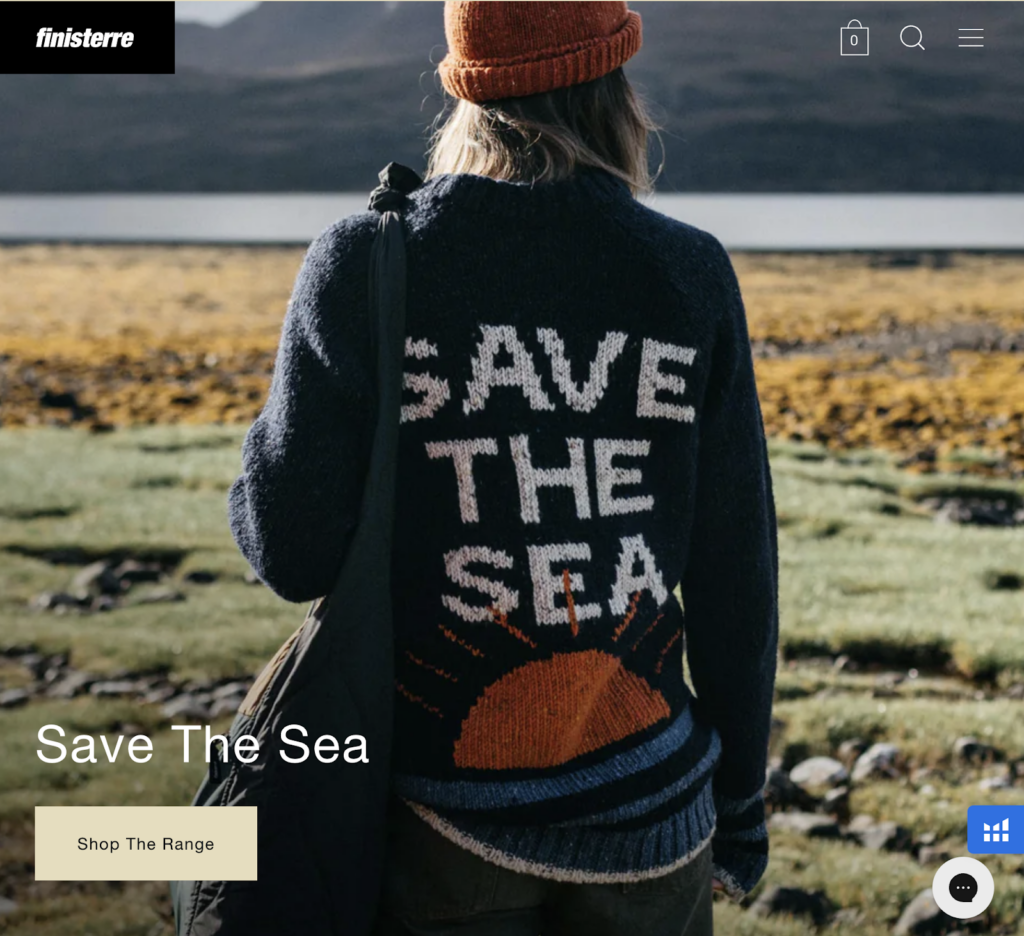
“Yet from our cliff top workshop, we stay true to our original design ethos of functionality and sustainability, remaining committed to product, environment and people.”
Tom Kay, Founder of Finisterre
🌎
How do they ensure their sustainability?
Finisterre places circular sourcing at the center of their sustainability commitment. They use renewable and recyclable textiles and biodegradable natural fibers and finishes. At least 50% of their clothes are made using recycled fabrics. For example, in 2022, 87% of the synthetic polymer fabrics used in Finisterre clothes were made using recycled fabrics, including polyester recovered from post-consumer and post-industrial waste. They also use low-impact natural fibers, including GOTS-certified organic cotton, hemp, linen, and bamboo. In 2019, they replaced all plastic packaging with water-soluble, ocean-safe, and biodegradable “Leave No Trace” garment bags. Finisterre also strives to reduce textile waste by offering repair services and giving in-store credits for gear trades-in, which would be reconditioned for resale. On top of that, they implement various incentives to reduce their carbon footprint, including switching more of their stores and offices to renewable energy tariffs and transporting products using less carbon-intensive modes on land and sea. Last but not least, Finisterre is a B Corporation.
🌐
How do they ensure their ethics?
Finisterre is committed to full transparency in their supply chain, holding their partners to the high standards in their Code of Conduct and their Anti-Slavery & Trafficking Policy. Additionally, they partner with Fair Working Conditions (FWC), enabling the mapping of their supply chain, the screening of suppliers, and targeted audits at high-risk locations. Their facilities are also listed on Open Supply Hub. Lastly, Finisterre’s ethical values extend to their dedication to saving the sea. For example, they provide a free resource to inspire ocean activism.
🤝
Are they part of any giving-back programs?
Finisterre provides financial support to various giving-back campaigns and programs through the Finisterre Foundation, championing ocean access for all. For example, Finisterre turned 2021’s Black Friday into Blue Friday, where they swapped discounts for donations, raising funds for The Wetsuit Project, which adapts wetsuits for children and adults with various disabilities to access the sea. In 2022, Blue Friday was used again to raise money supporting Level Water to provide specialist swimming lessons for children with disabilities. Other projects include The Seasuit Project, City Kids Surfing, Seasuit Donation, and Art Auctioning for Good.
🛍️
What is their product range?
- Best for: menswear, womenswear
- Product range: shirts, pants, tops, sweaters, dresses, hoodies, shorts, denim, swimwear, jackets, blazers, sweatshirts, T-shirts, base layers, socks, shorts,
- Price range: $$
- Size range: XS–XXL
VAUDE: Outdoor Gear and Activewear Where Performance Meets Ecology

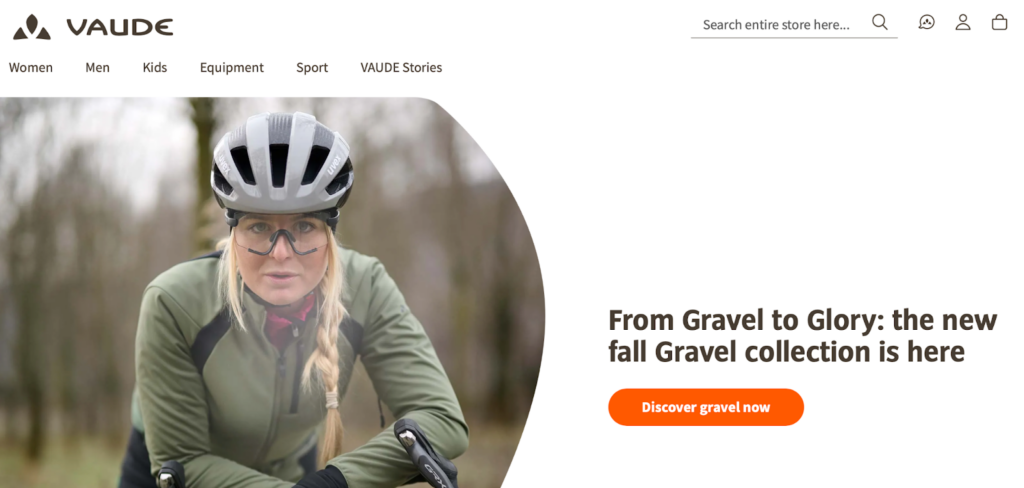
“We design with a focus on minimal material consumption, try to avoid waste and design products that are timeless, durable and repairable.”
VAUDE
🌎
How do they ensure their sustainability?
VAUDE prioritizes sustainability by creating a counterbalance to resource-consuming lifestyles. They achieve that by making durable and versatile products for life, minimizing waste during manufacturing, and enabling longer product lifespan with maintaining, repairing, donating, and upcycling guidance. VAUDE opts for materials that combine technical performance and ecological responsibility. An example of this is their use of merino wool, a natural fiber suitable for a warm and water-repellent protective layer that is ideal for mountain sports. Meanwhile, they lower the impact of this fabric by adhering to the Responsible Wool Standard and the Global Organic Textile Standard for virgin organic wool and increasing the content of GRS-certified recycled wool in their collection. Furthermore, their products have been certified by Bluesign® and Green Button. Regarding their impact, the brand sets science-based climate goals to reduce global emissions as quickly as possible, aligning with the Paris Agreement’s 1.5 degrees in global warming, and is on track with their target as of October 2022, according to Science Based Targets (SBTi). They achieved that by measuring the total carbon footprint and implementing reduction measures in hotspots like material, energy, and transport. Since the beginning of 2022, VAUDE has been a carbon-neutral company, achieved through fully offsetting their global greenhouse gas emissions in the My Climate’s climate change mitigation project in Vietnam, their most important country of production.
🌐
How do they ensure their ethics?
VAUDE ensures ethical practices for both humans and animals involved in their operation. They work with the Fair Wear Foundation to monitor their final stage of production, ensuring safe working conditions and fair wages for factory workers. They also audit 100% of their producers in high-risk countries. Additionally, VAUDE has a basic policy to support diversity and inclusion in their direct operations and supply chain. Regarding animal rights, they follow the Responsible Wool Standard, appropriately addressing sheep’s welfare and the land they graze on.
🤝
Are they part of any giving-back programs?
VAUDE donates FairWertung the products that can’t be repaired but are still perfectly functional. In 2021, VAUDE donated products with a merchandise value of approximately €339,000 (approximately $375,000 USD) to the network, which makes clothes affordable via charity shops or second-hand stores.
🛍️
What is their product range?
- Best for: sportswear (cycling, hiking, skiing) and urban outdoor clothes for women, men, and kids
- Product range: jackets, hoodies, sweaters, shirts, vests, pants, shorts, skirts, functional underwear
- Price range: $$$
- Size range: XS–XXXL
Nisolo: Carbon-Neutral Clothings and Gear From an Accountable and Transparent Brand

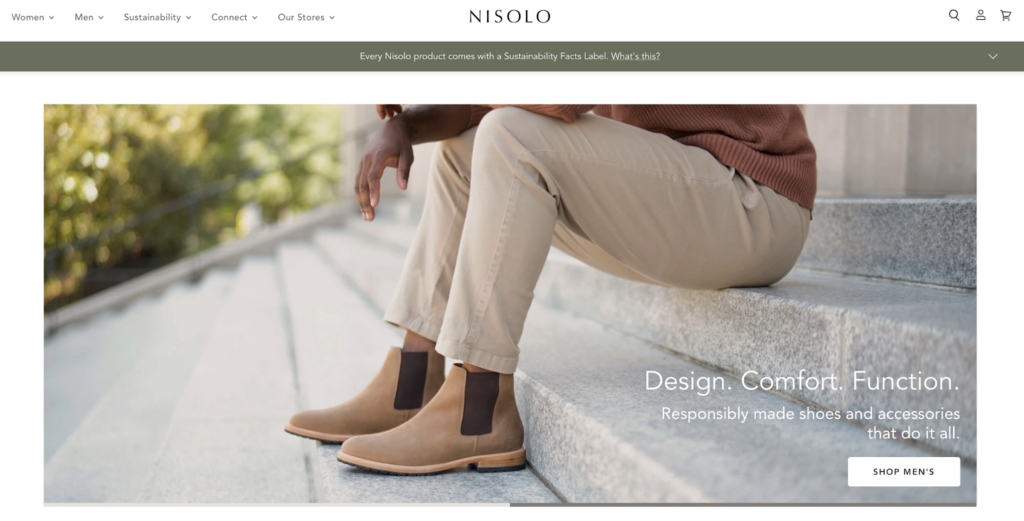
“As a brand focused on sustainability, we’re far from perfect. To hold ourselves more accountable in hopes the industry will begin to do the same, we’re raising the bar for transparency to an unprecedented level. ”
Nisolo
🌎
How do they ensure their sustainability?
Nisolo ensures their sustainability by reducing their impacts while working toward fixing the fashion industry. They focus on five critical areas: a living wage for all workers, net zero carbon emissions, transparency, accountability, and collaboration. Specifically, they pursue the balance between their carbon emissions and offsets. Firstly, Nisolo strives to reduce their carbon emissions throughout the life-cycle of their leather footwear and accessories. They opt for recycled and upcycled materials, sourcing synthetic materials made from recycled water bottles and leather as an economic by-product of the meat industry. Further down the life-cycle in the manufacturing stage, they use renewable energy for a significant percentage of their production. At the end of the product’s life-cycle, they facilitate recycling and responsible disposal through their takeback program with Soles4Souls, further reducing the life-cycle’s environmental impacts. Since 2018, Nisolo has offset all the carbon emissions that they haven’t managed to cut by partnering with Ecosphere+ to invest in forest conservation in the Peruvian Amazon—an offsetting project verified by Climate Neutral. Lastly, they are a carbon-neutral certified brand.
🌐
How do they ensure their ethics?
Nisolo ensures their ethics by upholding all their 1st tier factories to their Supplier Code of Conduct, which covers all of the ILO’s Fundamental Principles and Rights at Work. They ensure that every producer in their 1st tier factories is paid a living wage by monitoring individual living wages and tracking suppliers’ lowest wages. Nisolo also monitors health and safety issues with an internal procedure. Moreover, they are fully transparent about their impacts with their sustainability facts labels so that consumers can see the carbon footprint and the workforce involved with each product they purchase. Regarding animal welfare, Nisolo is a member of the Leather Working Group, which promotes sustainable environmental practices in the leather industry.
🤝
Are they part of any giving-back programs?
Nisolo founded The Lowest Wage Challenge in collaboration with another fashion label, ABLE, to challenge brands to share their lowest wages and strive toward paying their workers a living wage throughout their supply chains.
🛍️
What is their product range?
- Best for: menswear, womenswear
- Product range: shoes, bags, wallets, belts, socks, accessories
- Price range: $$$
- Size range: S–L
Iron Roots: Natural Athletic Apparel
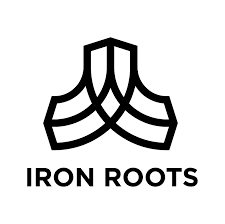
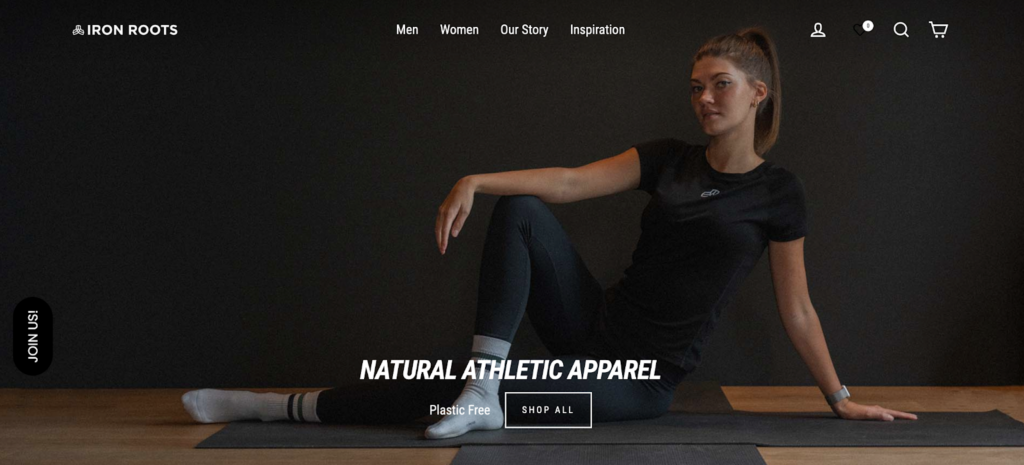
“By combining design, functionality and sustainability, we aim to create the best sportswear.”
Iron Roots
🌎
How do they ensure their sustainability?
Iron Roots prioritizes sustainability by using eco-friendly plant-based textiles, cutting down textile waste, and reducing carbon footprint. Firstly, they source a high proportion of low-impact textiles, including GOTS-certified cotton, hemp, and lyocell (Lenzing‘s TENCEL™ fibers)—three of the most sustainable fabrics. Additionally, all their healthy sportswear is tested for harmful chemicals through OEKO-TEX® certifications. Secondly, Iron Roots minimizes textile waste in multiple ways, such as designing a product from a single fabric, maximizing cutting efficiency, and sometimes using the same fabric for various products. On top of that, they offer a take-back program where customers can return their worn-out Iron Roots apparel for the purpose of recycling it into new products. Lastly, to avoid overproduction, they do not offer seasonal collections. Regarding their carbon footprint, Iron Roots manufactures locally to reduce their transporting carbon emissions and offset all those occurring from shipping in their supply chain.
🌐
How do they ensure their ethics?
Iron Roots traces most of their supply chain. The manufacturing stage happens in GOTS and SMETA-certified factories in Greece, North Macedonia, and Portugal. The factory’s workers are paid living wages that average 1.5–1.7 times the minimum wage in their country.
🤝
Are they part of any giving-back programs?
Iron Roots donates 50% of the profits from the Iron Roots x Sea Shepherd Wood T-shirt sale to Sea Shepherd, helping to protect the oceans.
🛍️
What is their product range?
- Best for: womenswear, menswear
- Product range: activewear, sportswear, hoodies, sweatshirts, accessories
- Price range: $$$
- Size range: XS–XXL
Sealand: Weather Resistant Gear Made From Upcycled and Responsibly Sourced Materials
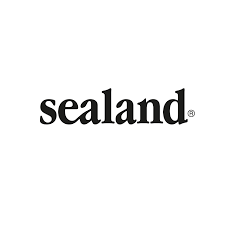

“Through environmentally efficient material selection, innovative design and product durability, we have sought to both slow down the rate of consumption and reduce the environmental damage caused by production.”
Sealand
🌎
How do they ensure their sustainability?
Sealand ensures sustainability by sourcing a high proportion of eco-friendly materials and achieving net zero carbon via reducing and offsetting emissions. Firstly, they lower their sourcing environmental impacts by combining three categories of low-impact textiles: upcycled fabrics, durable natural fabrics, and recycled fabrics (ECONYL® Regenerated Nylon). Specifically, they upcycle yacht sails, poly twill, spinnaker, and canvas. Sealand also uses hemp and CmiA-certified cotton (cultivated from rainwater-fed, non-GMO crops in sub-Saharan Africa). Regarding their carbon footprint, they partner with The Green House to measure their emissions. The calculations show that Sealand’s upcycled canvas and yacht sail bags are 99% more carbon efficient than a bag made from virgin canvas. Additionally, the brand has purchased carbon credits from Credible Carbon to offset all the emissions resulting from producing their gear. They also implement a carbon credit management system that tracks carbon emissions and credits.
🌐
How do they ensure their ethics?
Sealand traces most of their supply chain and visits their suppliers regularly. They state that they pay a living wage, which is, on average, 40% higher than the South African living wage.
🤝
Are they part of any giving-back programs?
Sealand pledges, in partnership with 1% for the Planet, to donate 1% of their sales to address key environmental challenges and disparities that exist in their socio-economic context. Specifically, they support Sentinel Ocean Alliance (SOA) to provide environmental education, ocean stewardship, and conservation in Sealand’s direct environment, Hout Bay. Additionally, they donate an upcycled bag to an aligned initiative for every online order over R1,500 ($80 USD).
🛍️
What is their product range?
- Best for: menswear, womenswear
- Product range: shoes, bags, wallets, belts, socks, accessories
- Price range: $$$
- Size range: n/a
Rapanui: Made-To-Order Clothes Using Highly Sustainable Materials

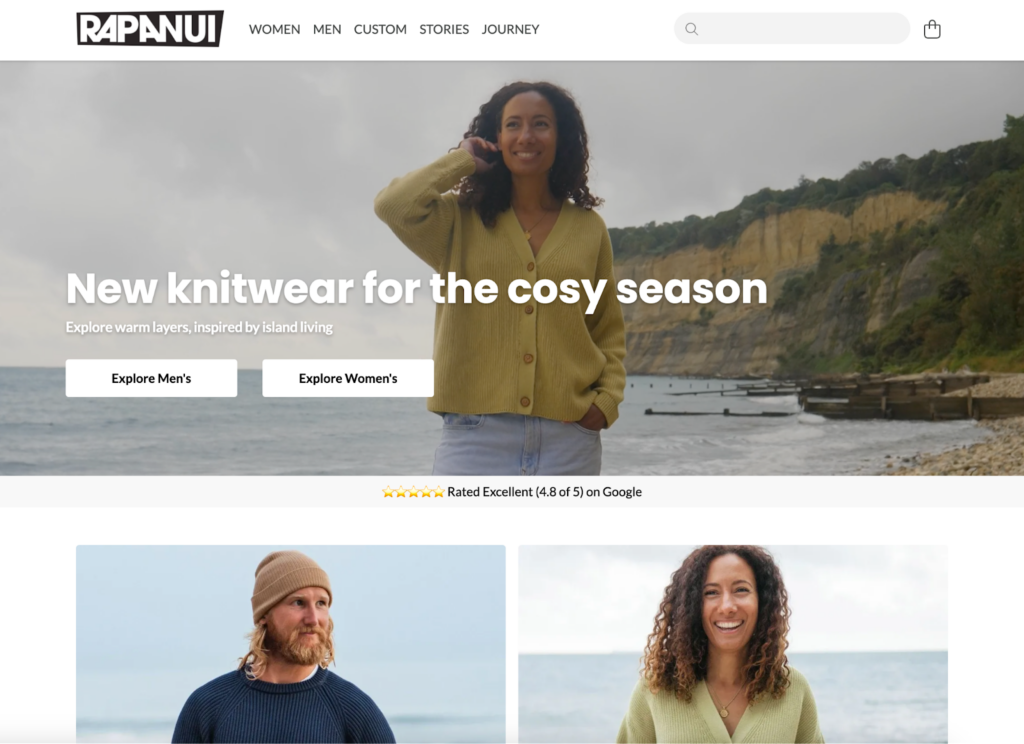
“Our commitment to a cleaner way of living and doing business has made us stronger and, like any good relationship, we take every day as it comes.”
Rapanui
🌎
How do they ensure their sustainability?
Rapanui promotes sustainability by sourcing organic and recycled materials, operating on renewable energy, and removing plastic from packaging. In particular, their products are designed for the circular economy, where they can be returned and remade. They also recover organic material from worn-out Rapanui products sent back to them and blend them with organic cotton to make new yarn. On top of that, they print their clothes in real-time, making what people need when they need it while reducing both the associated waste and cost. Their packaging is also plant-based instead of plastic. Furthermore, about 95% of the water used to dye Rapanui products is recovered, cleaned, and recirculated. And lastly, their supply chain uses renewable energy (solar and wind).
🌐
How do they ensure their ethics?
Rapanui traces most of their supply chain.
🤝
Are they part of any giving-back programs?
Rapanue shares access to the supply chain and the technology they have developed on Teemill. This open-source circular fashion platform empowers other entrepreneurs to start their own sustainable clothing brands.
🛍️
What is their product range?
- Best for: menswear, womenswear
- Product range: T-shirts, jumpsuits, playsuits, pants, shorts, hoodies, sweatshirts, socks, underwear
- Price range: $
- Size range: S–L
Will’s Vegan Store: Vegan Shoes, Clothes, and Accessories From a Climate-Neutral Business

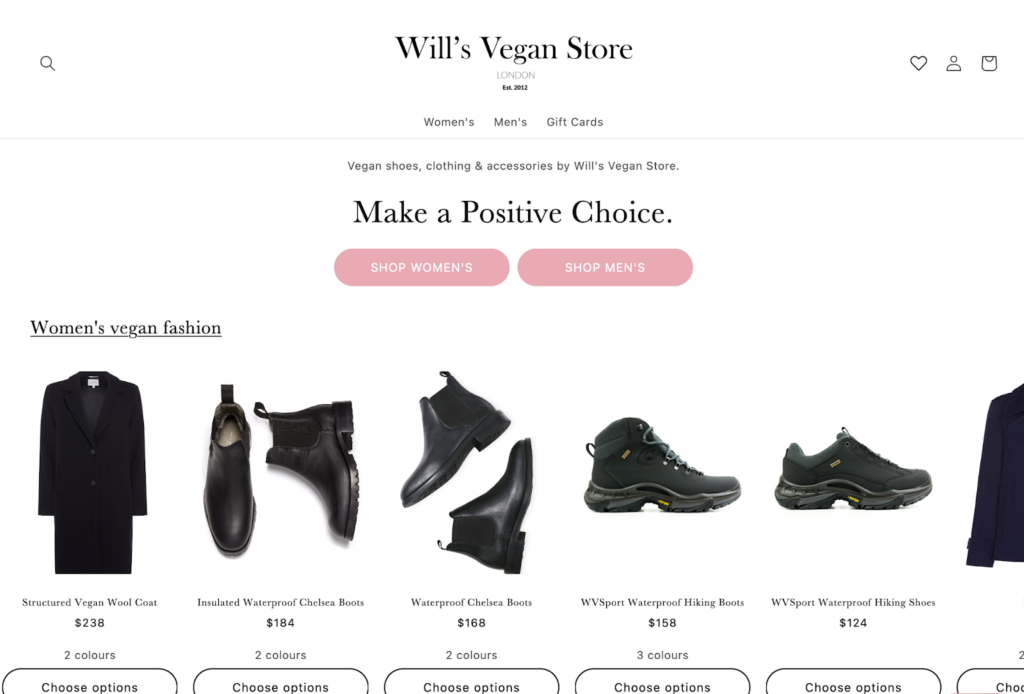
“We use sustainable materials as much as possible.”
Will’s Vegan Store
🌎
How do they ensure their sustainability?
Will’s Vegan Store promotes sustainability by using low-impact natural fabrics or recycled materials whenever possible. In 2020, they introduced their carbon-neutral LDN Biodegradable Sneakers made with lyocell, organic cotton, and natural latex insoles. Additionally, they are transitioning into bio-based vegan leather, replacing plastic-based materials and eliminating animal-derived leather. The latest vegan leather version they source contains 69% natural oil and 31% polyurethane (PU) with backing fabric made with eucalyptus-based viscose. Where they can’t find a suitable natural material, they source recycled materials instead of high-impact virgin versions, including recycled polyester and recycled nylon. Furthermore, Will’s Vegan Store operates a plastic-free supply chain where all deliveries use exclusively paper shipping bags, cardboard boxes, and paper tape. Lastly, they offset 100% of their carbon emissions in environmental projects, for example, to avoid deforestation in Papua New Guinea and Columbia.
🌐
How do they ensure their ethics?
Will’s Vegan Store partly traces their supply chain. Regarding animal welfare, they avoid animal cruelty practices by making their entire product range vegan.
🤝
Are they part of any giving-back programs?
Will’s Vegan Store is not known to be part of any giving-back programs.
🛍️
What is their product range?
- Best for: womenswear, menswear
- Product range: coats, jackets, knitwear, shoes, sneakers, boots, pumps, heels, skirts, dresses, accessories
- Price range: $$
- Size range: XS–XXL
The Level Collective: Organic Cotton Backpacks That Are Designed for Work and Play in the Wild
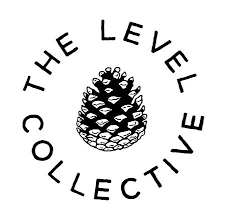
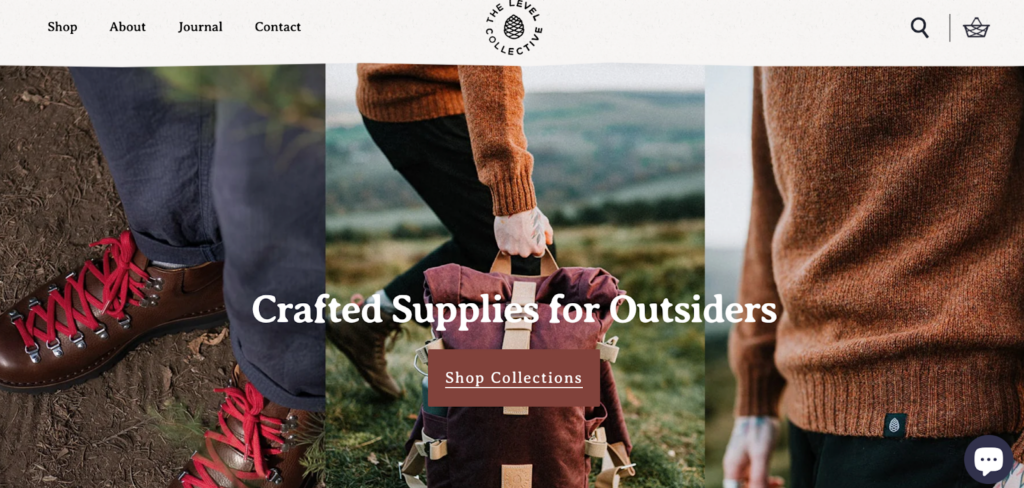
“We lead by example, putting people and planet before profit, and craft purposeful product as an expression of these values. Timeless supplies inspired by adventures in the seasons found outside, not those dictated by fashion.”
The Level Collective
🌎
How do they ensure their sustainability?
The Level Collective ensures sustainability by opting for low-impact varieties of natural fabrics for their backpacks. Specifically, they use organic cotton instead of conventional cotton for the outer shell, recycled wool instead of virgin wool (or fossil-based foam) for the padding, and chromium-free undyed leather instead of chemically tanned leather for the details. Additionally, The Level Collective designs their products for longevity to reduce waste along with the life-cycle impact. They also show their commitment by offering a lifetime of free repairs for their backpacks. To further reduce waste, the brand limits their production runs, uses minimal, recycled, and recyclable packaging, and buys back their worn-out products.
🌐
How do they ensure their ethics?
The Level Collective upholds their suppliers to a Supplier Code of Conduct, which covers four of the ILO’s Fundamental Principles and Rights at Work. They also trace most of their supply chain. Furthermore, most of their products, backpacks included, are manufactured in Britain and Europe under stringent labor laws. In addition, they source blank, off-the-shelf T-shirts and sweaters ethically made from GOTS-certified organic cotton in Bangladesh in Fair Wear Foundation-certified factories.
🤝
Are they part of any giving-back programs?
The Level Collective pledges 3% for People & Planet, donating 3% of their annual profits to charity partners who support vulnerable communities and protect our planet. Additionally, they opt for Mail Out, a social enterprise that specifically trains and employs adults with learning difficulties to pick, pack, and post their orders.
🛍️
What is their product range?
- Best for: womenswear, menswear
- Product range: backpacks, wool knitwear, shirts, jackets, T-shirts, sweaters, hats, socks, accessories, trainers, boots
- Price range: $$$
- Size range: XS–XL
Seea: Small Batch, Locally Produced Swimsuits Designed for Women Who Love the Sea
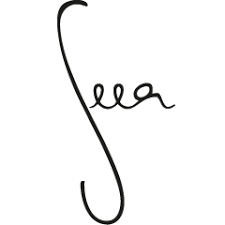

“A celebration of the style, rhythm, and grace of women’s surfing. These suits are made for you.” Amanda Lapham,
Co-founder of Seea
🌎
How do they ensure their sustainability?
Seea ensures their sustainability by sourcing a medium proportion of eco-friendly fabrics. Specifically, they no longer use neoprene, a conventional material for wetsuits made from harmful petrochemicals. Indeed, they’ve switched to Yulex, a plant-based material derived from FSC-certified rubber trees. Additionally, Seea sources deadstock and recycled fabrics to lower their environmental impact. Further down the life-cycle in the manufacturing stage, Seea produces in small batches to avoid textile waste and locally in California to reduce transportation carbon footprint.
🌐
How do they ensure their ethics?
Seea traces most of their supply chain and visits some suppliers regularly.
🤝
Are they part of any giving-back programs?
Seea is not known to be part of any giving-back programs.
🛍️
What is their product range?
- Best for: womenswear, girlswear
- Product range: surf suits, one-piece swimwear, bikinis, bodysuits, rash guards, wetsuits, pants, jackets, shorts, ponchos, capes, shorts, surf accessories
- Price range: $$
- Size range: XS–XL
Duckworth: Sheep to Shelf™ US-Made Merino Outdoor Clothing for a Mountain Lifestyle


“Our clothes are built to last and perform, tapping sustainable fibers and low-impact processes right here in the US – a combination of ethical practices even our competitors in the Merino Wool space simply can’t match.”
Duckworth
🌎
How do they ensure their sustainability?
Duckworth promotes sustainability by making durable and versatile outdoor apparel using merino wool. They source these soft and breathable fibers from the Helle Rambouillet sheep—a close cousin to merino sheep—that roam wildly in the founders’ ranch. The ranch lies from 5,000′ to 9,000′ elevation in the Northern Rockies of Montana, where the conditions are just right for their herd to grow exceptionally soft wool. At Duckworth, not only the sourcing stage but the entire process happens in the US, from sheep ranching to wool processing, yarn spinning, fabric milling, and finishing, altogether reducing the carbon footprint of transportation.
🌐
How do they ensure their ethics?
Duckworth is completely transparent about their supply chain from beginning to end. In particular, Duckworth owns their sheep that live as wild animals, coming in contact with humans a few days per year when they’re shaved for the summer months.
🤝
Are they part of any giving-back programs?
Duckworth, in an effort to strengthen the US wool industry, has joined up with their merino wool producer, Helle Rambouillet, to donate $50,000 to build a new Montana Wool Lab at Montana State University. This marks one of only two wool research and service laboratories in the entire US.
🛍️
What is their product range?
- Best for: menswear, womenswear
- Product range: tops, bottoms, sweatshirts, hoodies, jackets, vests, base layers, socks, accessories
- Price range: $$$
- Size range: XS–XXL
Salty Gypsy: Women’s Surf Lifestyle Clothing and Gear Made Ethically

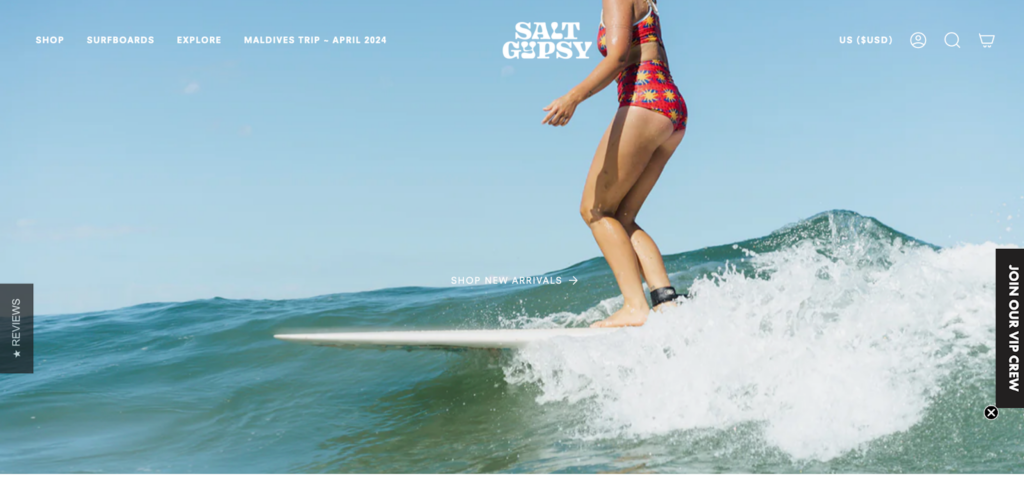
“We focus on developing stylish & long-lasting products for discerning women of the sea.”
Salty Gypsy
🌎
How do they ensure their sustainability?
Salty Gypsy ensures their sustainability by using a high proportion of lower-impact materials. They source ECONYL® regenerated nylon in their surf garments to help reduce plastic waste, avoid dipping into the nonrenewable fossil reserve, and lower the global warming impact of using nylon. Furthermore, they produce locally in Australia to reduce transportation carbon footprint. Salty Gypsy also encourages consumers to buy pre-loved items, sell used suits, and recycle. Lastly, they partner with re-mint and UPPAREL on their circular initiatives.
🌐
How do they ensure their ethics?
Salty Gypsy holds their final stage of production in Australia, a low-risk country for labor abuse, and publicly shares their makers. They also visit their manufacturing partners every week.
🤝
Are they part of any giving-back programs?
Salty Gypsy is not known to be part of any giving-back programs.
🛍️
What is their product range?
- Best for: womenswear,
- Product range: surfwear, surfboards, accessories
- Price range: $$
- Size range: XS–XL
Why Is It Important to Buy Products Made of More Sustainable Fabrics
It is important to buy products made of more sustainable fabrics because a sustainable textile industry has a lower carbon footprint, helps save natural resources, and is better for forests, animals, and humans.
Buying Sustainable Fabrics Reduces Your Carbon Footprint
The production of clothing and footwear is estimated to contribute 10% of global greenhouse gas emissions—more than all international flights and shipping combined. If the fashion industry were a country, it would be the fourth largest emitter of carbon dioxide.
One way to reduce the carbon footprint of the clothes you buy is to opt for sustainable fabrics. Sustainable fabrics, which are often made with natural or recycled fibers, have relatively low carbon footprints compared to petroleum-based fabrics. For example, organic cotton made in the US has a carbon footprint of 2.35 kg CO2 (per ton of spun fiber)—a quarter of polyester’s carbon footprint.
Buying Sustainable Fabrics Reduces Demand For Natural Resources and Waste Management
The textile industry uses water and land to grow cotton and other fibers. It is estimated that 79 billion cubic meters of water were used for the sector worldwide in 2015. For example, producing a single cotton T-shirt requires as much water as one person drinks for 2.5 years (2,700 liters of fresh water).
Worse yet, the textile economy is vastly more linear than circular: the largest amount of resources used in clothes ended up in landfills (instead of being recycled to remake clothes). According to a report by the Ellen MacArthur Foundation,
- Less than 3% of materials used in the textile economy in 2015 came from recycled sources.
- In other words, more than 97% of resources used in making clothes are newly extracted.
When clothing items are disposed of within a short period of time—under a year in the case of half of the fast fashion clothes—the natural systems that provide raw materials for fabrics don’t have enough time to recover and regenerate, which could lead to ecological breakdown.
Sustainable fabrics are made with less water and emissions while lasting longer:
- Because they are durable, you don’t need to buy new clothes too often.
- Thus, you help reduce the pressure to extract more resources for making new items.
Similarly, making and consuming sustainable fabrics made with recycled materials reduces the demand for virgin materials while helping tackle waste management.
Buying Sustainable Fabrics Encourages Sustainable Management of Forests
Sustainable natural fiber fabrics are made with raw materials from forests and plantations that are sustainably managed, such as complying with FSC standards.
When you buy sustainable natural fiber fabrics, you discourage unsustainable forestry practices like illegal logging. You can help reduce deforestation, biodiversity loss, and the effects of climate change.
Buying Sustainable Fabrics Encourages Fairer Treatment of Animals
The fashion industry is rife with animal mistreatment when it comes to making animal-based fabrics like wool or silk. Every year, billions of animals suffer and die for clothing and accessories.
Buying sustainable vegan alternatives can help to reduce the pressure on raising more and more animals to meet the demand for animal-based fabrics while sacrificing their well-being and lives.
Suppose you have to buy fabrics made with, for example, wool or silk; make sure you only choose brands committed to cruelty-free products. In that case, you help advocate better treatments for animals raised within the textile industry.
Using Sustainable Fabrics Encourages Fairer Treatment of Textile Workers
Recent statistics from UNICEF estimated as many as 170 million child laborers worldwide, many of whom were engaged in some form of work in the textile industry. They don’t get paid minimum wages and often work long hours.
When you buy sustainable fabrics from brands transparent about the working conditions at their factories, you discourage the use of child labor and help promote better working conditions for textile workers.
How Can You Generally Buy More Sustainable Fabrics
The key to sustainably buying fabrics is to check on relevant environmental and original certifications.
For natural fabrics:
- Global Organic Textile Standard (GOTS): A globally recognized certification system that ensures a certain threshold of organic content has been met. It covers manufacturing, packaging, labeling, transportation, and distribution (but not what happens in the fields where crops are grown).
- USDA Certified Biobased Product: The USDA BioPreferred® Certification is a voluntary certification offered by the United States Department of Agriculture. The certification identifies products made from plants or other renewable materials.
- Ecolabel: Ecolabel is the official European Union voluntary label recognized worldwide for certified products with a guaranteed, independently verified low environmental impact. The label requires high environmental standards throughout the entire life-cycle: from raw material extraction through production and distribution to disposal. It also encourages companies to develop innovative, durable, easy-to-repair, and recyclable products.
For natural fiber semi-natural/semi-synthetic fabrics:
- Forest Stewardship Council: An FSC certification ensures that the wood (or wood-like material) comes from responsibly managed forests that provide environmental, social, and economic benefits.
There are two types of FSC Certification:- FSC Forest Management Certification, with a focus on the origin of the wood—the forest.
- FSC Chain of Custody Certification, which focuses on the path from the forest to the customer’s home.
- Program for Endorsement of Forest Certification: PEFC’s approaches to sustainable forest management are in line with protecting the forests globally and locally and making the certificate work for everyone. Getting a PEFC certification is strict enough to ensure the sustainable management of a forest is socially just, ecologically sound, and economically viable but attainable not only by big but small forest owners.
For recycled fabrics:
- Recycled Claim Standard (RCS): The Textile Exchange RCS was originally developed as an international, voluntary standard that sets requirements for third-party certification of Recycled input and chain of custody.
- The Global Recycled Standard (GRS): The Global Recycled Standard (GRS) is an international, voluntary, full product standard that sets requirements for third-party certification of Recycled Content, chain of custody, social and environmental practices, and chemical restrictions. It can be used for any product with more than 20% recycled material.
For all types of fabrics:
- STeP by OEKO-TEX®: STeP by OEKO-TEX® is an independent certification system for brands, retailers, and manufacturers from the textile and leather industry. It communicates organizational environmental measures, including reducing carbon footprint and water usage.
- OEKO-TEX® Standard 100: OEKO-TEX® labels aim to ensure that products pose no risk to human health (i.e., containing banned chemicals).
Some certifications that are signaling brands’ efforts toward lowered environmental impacts and a circular economy are:
- B Corp Certification: The label B Corp is a certification reserved for for-profit companies. Certified holders are assessed on their social and environmental impacts.
- Cradle2Cradle certification: Cradle2Cradle provides a standardized approach to material circularity. It assesses whether products have been suitably designed and made with the circular economy in mind covering five critical categories: material health, material reuse, renewable energy and carbon management, water stewardship, and social fairness.
Final Thoughts
The fast fashion industry has pushed for trendy lifestyle clothing items and gear that need frequent replacement. Yet, the environmental impacts of making and landfilling something like a pair of training shoes can be enormous, especially when they contain certain materials. Thus, it is important to shop with ethics and sustainability in mind when choosing your next pair of running shorts or cycling gloves.
By purchasing lifestyle clothing and gear from brands that commit to sustainability, you support their mission to create a fairer and less harmful textile industry for all lives on Earth.
Here is the list (again) of the most sustainable lifestyle clothing brands:
- Patagonia
- United by Blue
- Finisterre
- VAUDE
- Nisolo
- Iron Roots
- Sealand
- Rapanui
- Will’s Vegan Store
- The Level Collection
- Seea
- Duckworth
- Salty Gypsy
To make your use of these clothing items even more sustainable, follow these steps:
- Buy recycled or upcycled items made with low-impact materials.
- Keep your items for as long as possible.
- At the end-of-life of your clothes, upcycle the materials to extend their usage and arrange for them to be recycled or properly disposed of.
Stay impactful,

Sources
- Science Direct: Life-cycle assessment (LCA)
- Patagonia: Home
- United by Blue: Home
- Finisterre: Home
- VAUDE: Home
- Nisolo: Home
- Iron Roots: Home
- Sealand: Home
- Rapanui: Home
- Will’s Vegan Store: Home
- The Level Collection: Home
- Seea: Home
- Duckworth: Home
- Salty Gypsy: Home
- Good On You: The Ultimate Guide to More Ethical and Sustainable Activewear
- Patagonia: The Climate Crisis Is Our Business
- Patagonia: The Climate Crisis Is Our Business | No More Virgin Petroleum Fibers by 2025
- Patagonia: The Climate Crisis Is Our Business | Is Each Product Worth the Environmental Cost?
- Patagonia: The Climate Crisis Is Our Business | Help Suppliers Cut Emissions
- Patagonia: Environmental Responsibility
- Patagonia: Regenerative Organic Certified fibers
- Patagonia: Hemp
- Patagonia: Man-made Cellulose Fibers
- Patagonia: Recycled Cotton
- Patagonia: Recycled Polyester
- Patagonia: WORN WEAR
- B Corporation: Patagonia
- Bluesign: Home
- Fair Trade: Home
- FAIR TRADE CERTIFIED: Improving Lives, Protecting the Planet.
- Patagonia: Social Responsibility
- Patagonia: Fair Trade
- Patagonia: Fair Labor Association
- Patagonia: Living Wage Program
- Patagonia: Migrant Workers Program
- Patagonia: Responsible Purchasing Practices
- Patagonia: Where We Do Business
- Patagonia: 1% for the Planet
- Forbes: Yvon Chouinard And The Patagonia Purpose Trust— What Is It And Will It Work?
- Fast Company: Patagonia uses capitalism to save the planet with the Holdfast Collective
- The New York Times: Patagonia Founder Gives Away the Company to Fight Climate Change
- B Corporation: United by Blue
- United by Blue: Backpacks
- United by Blue: Our Story
- Good On You: Brand Directory | United by Blue
- United by Blue: Materials
- Impactful Ninja: How Sustainable Are Recycled Fabrics? A Life-Cycle Analysis
- Impactful Ninja: How Sustainable Are Organic Cotton Fabrics? A Life-Cycle Analysis
- Global Organic Textile Standard: Home
- Textile Exchange: Organic Content Standard
- Impactful Ninja: How Sustainable Are Recycled Cotton Fabrics? A Life-Cycle Analysis
- Textile Exchange: Global Recycle Standard
- OEKO-TEX: Home
- Impactful Ninja: How Sustainable Are Recycled Wool Fabrics? A Life-Cycle Analysis
- Textile Exchange: Responsible Wool Standard
- Impactful Ninja: How Sustainable Are Recycled Polyester Fabrics? A Life-Cycle Analysis
- Impactful Ninja: How Sustainable Are Recycled Nylon Fabrics? A Life-Cycle Analysis
- Impactful Ninja: How Sustainable Are Hemp Fabrics? A Life-Cycle Analysis
- Impactful Ninja: How Sustainable Are Cashmere Fabrics? A Life-Cycle Analysis
- Impactful Ninja: How Sustainable Are Viscose Fabrics? A Life-Cycle Analysis
- Lenzing: Home
- Impactful Ninja: How Sustainable Are Ecovero Fabrics? A Life-Cycle Analysis
- United by Blue: Plastic Free
- United by Blue: IMPACT REPORT
- United by Blue: Code of Conduct
- International Labour Organization: Fundamental Principles and Rights at Work
- United by Blue: Manufacturing
- Bluesign: Home
- Amfori: BSCI
- SA International – SA8000 Standard
- WRAP Compliance: Home
- Impactful Ninja: How Sustainable Are Wool Fabrics? A Life-Cycle Analysis
- United by Blue: Community Cleanups
- United by Blue: Corporate Cleanups
- United by Blue: DIY Cleanups
- United by Blue: High Yield Cleanups
- United by Blue: International Cleanups
- Finisterre: Fabric of Finisterre
- Finisterre: Recycled Fabrics
- Impactful Ninja: How Sustainable Are Recycled Fabrics? A Life-Cycle Analysis
- Global Organic Textile Standard (GOTS): Home
- Impactful Ninja: How Sustainable Are Organic Cotton Fabrics? A Life-Cycle Analysis
- Impactful Ninja: How Sustainable Are Linen Fabrics? A Life-Cycle Analysis
- Impactful Ninja: How Sustainable Are Bamboo Fabrics? A Life-Cycle Analysis
- Finisterre: Impact Reports
- Finisterre: Repair Workshop
- Finisterre: Finisterre x RESKINNED | REPURPOSING OLD GEAR FOR NEW ADVENTURES
- Finisterre: POSITIVE IMPACT REPORT 2022
- B Corporation: Finisterre
- Finisterre: Finisterre – A Positive Impact Business
- Finisterre: Anti-Slavery and Trafficking Policy
- Fair Working Conditions (FWC): Home
- Finisterre: Factories of Finisterre
- Open Supply Hub: Home
- Finisterre: Sea7 | The Materclasses
- Finisterre Foundation CIC: Grant Making Policy
- Finisterre: Finisterre Foundation | The Wetsuit Project
- Level Water: Home
- Finisterre: Finisterre Foundation | The Seasuit Project
- Finisterre: Finisterre Foundation | City Kids Surfing
- VAUDE: CSR Report | Produce Philosophy
- Good On You: Brand Directory | VAUDE
- VAUDE: CSR Report | Don’t wash any more than necessary
- VAUDE: CSR Report | Repair Don’t Replace
- VAUDE: CSR Report | Second-hand and donations
- VAUDE: CSR Report | Upcycling
- VAUDE: CSR Report | Material Policy
- Impactful Ninja: How Sustainable Are Merino Wool Fabrics? A Life-Cycle Analysis
- VAUDE: CSR Report | Wool
- Bluesign: Home
- Green Button: Home
- Science Based Targets (SBTi): Home
- VAUDE: CSR Report | Climate Footprint
- VAUDE: CSR Report | Climate-Neutral Business
- VAUDE: CSR Report | Our Producers
- FairWertung: Home
- CHANGE CLIMATE: Nisolo is Climate Neutral Certified
- Nisolo: Materials & Trims
- Nisolo: WE’RE CLIMATE NEUTRAL CERTIFIED FOR 2023!
- Nisolo: Climate Action
- Good On You: Brand Directory | Nisolo
- Impactful Ninja: How Sustainable Are TENCEL Fabrics? A Life-Cycle Analysis
- ASAHI KASEI: ROICA
- THE SLOW LABEL: The problem with Elastane: ROICA™ V550 is an alternative
- Impactful Ninja: How Sustainable Are Spandex Fabrics? A Life-Cycle Analysis
- Impactful Ninja: How Sustainable Are Elastane Fabrics? A Life-Cycle Analysis
- Bluesign: Home
- European Union: REACH Regulation
- Impactful Ninja: How Sustainable Are Organic Cotton Fabrics? A Life-Cycle Analysis
- B Corporation: Nisolo
- Nisolo: Women’s Leather Handbags, Totes & More
- Nisolo: Sustainability
- Impactful Ninja: How Sustainable Are Leather Fabrics? A Life-Cycle Analysis
- Impactful Ninja: How Sustainable Are Synthetic Fabrics? A Life-Cycle Analysis
- Nisolo: Can leather be sustainable?
- Nisolo: Behind The Scenes of Our Operation
- Nisolo: SHOE RECLAMATION PROGRAM
- Ecosphere+: Home
- Nisolo: How Our 0% Net Carbon Commitment Combats Climate Change AND, WHY WE’RE CLIMATE NEUTRAL CERTIFIED
- CHANGE CLIMATE: Nisolo is Carbon Neutral Certified
- Nisolo: Supplier Code of Conduct
- Good On You: Brand Directory | Nisolo
- International Labour Organization: ILO’s Declaration on Fundamental Principles and Rights at Work
- Nisolo: Our Lowest Wage & The Lowest Wage Challenge
- Nisolo: Sustainability Facts Label
- Leather Working Group: Home
- Good On You: Brand Directory | Iron Roots
- Impactful Ninja: How Sustainable Are Cotton Fabrics? A Life-Cycle Analysis
- Impactful Ninja: How Sustainable Are Hemp Fabrics? A Life-Cycle Analysis
- Lenzing: Home
- Impactful Ninja: 10 Most Sustainable Fabrics: The Full Life-Cycle Analysis
- Iron Roots: Healthy Sportswear
- Iron Roots: Fair Production
- Iron Roots: FAQ
- Iron Roots: SUSTAINABILITY POLICY
- Iron Roots: Iron Roots x Sea Shepherd Wood T-shirt
- Good On You: Brand Directory | Sealand
- Sealand: Responsibility
- Sealand: Materials
- Impactful Ninja: How Sustainable Are Natural Fabrics? A Life-Cycle Analysis
- Impactful Ninja: How Sustainable Are Recycled Fabrics? A Life-Cycle Analysis
- Impactful Ninja: How Sustainable Are ECONYL Fabrics? A Life-Cycle Analysis
- Impactful Ninja: How Sustainable Are Canvas Fabrics? A Life-Cycle Analysis
- Impactful Ninja: How Sustainable Are Hemp Fabrics? A Life-Cycle Analysis
- Cotton made in Africa: Home
- Credible Carbon: Home
- One Percent For The Planet: Home
- Sentinel Ocean Alliance: Home
- Rapanui Clothing: Journey
- Rapanui Clothing: The future, remade.
- Good On You: Brand Directory | Rapanui Clothing
- Teemill: A Circular Economy Supplier
- Organic Basics: FAQ
- Global Organic Textile Standard (GOTS): Home
- OEKO-TEX: STANDARD 100 by OEKO-TEX®
- Textile Exchange: The RCS and GRS are designed to boost the use of recycled materials.
- Impactful Ninja: How Sustainable Are Elastane Fabrics? A Life-Cycle Analysis
- Made2Flow: Home
- One Carbon World: Home
- CHANGE CLIMATE: Will’s Vegan Store is Climate Neutral Certified
- Will’s Vegan Store: Vegan Men’s LDN Biodegradable Sneakers
- Impactful Ninja: How Sustainable Are Lyocell Fabrics? A Life-Cycle Analysis
- Will’s Vegan Store: Ethics & Sustainability
- Impactful Ninja: How Sustainable Are Viscose Fabrics? A Life-Cycle Analysis
- Impactful Ninja: How Sustainable Are Recycled Polyester Fabrics? A Life-Cycle Analysis
- Impactful Ninja: How Sustainable Are Recycled Nylon Fabrics? A Life-Cycle Analysis
- Good On You: Brand Directory | Will’s Vegan Store
- The Level Collective: British Made, Waxed Canvas Backpacks
- Impactful Ninja: How Sustainable Are Natural Fabrics? A Life-Cycle Analysis
- The Level Collective: Why Organic Cotton?
- Impactful Ninja: How Sustainable Are Cotton Fabrics? A Life-Cycle Analysis
- Impactful Ninja: How Sustainable Are Recycled Wool Fabrics? A Life-Cycle Analysis
- Impactful Ninja: How Sustainable Are Wool Fabrics? A Life-Cycle Analysis
- The Level Collective: Our Backpack Ingredients
- Impactful Ninja: How Sustainable Are Leather Fabrics? A Life-Cycle Analysis
- The Level Collective: Warranty & Repair
- Good On You: Brand Directory | The Level Collective
- The Level Collective: 10 things that make us different
- The Level Collective: Buy Back Project
- The Level Collective: Code of Conduct
- International Labour Organization: Fundamental Principles and Rights at Work
- Global Organic Textile Standard (GOTS): Home
- Impactful Ninja: How Sustainable Are Organic Cotton Fabrics? A Life-Cycle Analysis
- Fair Wear Foundation: Home
- The Level Collective: 3% for People & Planet
- Mail Out: Home
- Good On You: Brand Directory | Seea
- Sewport: What is Neoprene Fabric: Properties, How its Made and Where
- Seea: Yulex
- Forest Stewardship Council: Home
- Seea: Materials
- Impactful Ninja: How Sustainable Are Recycled Fabrics? A Life-Cycle Analysis
- Seea: Manufacturing
- Highend Montana: HELLE RAMBOUILLET MERINO WOOL GROWN IN MONTANA
- The Dyrt: Duckworth Relies on Montana-Raised Sheep to Make the Coziest Merino Wool
- Duckworth: Supply Chain & Ethics
- Duckworth: Our Story
- Duckworth: Stewards of The Land: The Sheep Trail
- NORTHERN AG NETWORK: Helle Rambouillet, Duckworth Donate $50,000 to New Wool Lab
- B Corporation: Salty Gypsy
- Salty Gypsy: Sustainability
- Salty Gypsy: Meet Our Makers
- re-mint: Home
- UPPAREL: Home
- Salty Gypsy: Circularity
- European Parliament: The impact of textile production and waste on the environment (infographic)
- Science Direct: The challenge of “Depeche Mode” in the fashion industry – Does the industry have the capacity to become sustainable through circular economic principles, a scoping review
- Science Direct: Carbon Footprint of Textile and Clothing Products
- European Parliament: Environmental impact of the textile and clothing industry
- European Parliament: What if fashion were good for the planet?
- Ellen MacArthur Foundation: A New Textiles Economy: Redesigning fashion’s future
- McKinsey: Style that’s sustainable: A new fast-fashion formula
- Forest Stewardship Council: Home
- Our World in Data: Deforestation and Forest Loss
- Our World in Data: Renewable Energy
- Peta: Animals Used For Clothing
- The Guardian: Child labour in the fashion supply chain
- Impactful Ninja: How Sustainable Are Natural Fabrics? A Life-Cycle Analysis
- Global Organic Textile Standard (GOTS): Home
- BioPreferred: WHAT IS THE BIOPREFERRED PROGRAM?
- European Commission: Environment | EU Ecolabel
- Impactful Ninja: How Sustainable Are Semi-Natural/Semi-Synthetic Fabrics? A Life-Cycle Analysis
- Forest Stewardship Council
- FSC Forest Management Certification
- FSC Chain of Custody Certification
- Textile Exchange: The RCS and GRS are designed to boost the use of recycled materials
- Program for Endorsement of Forest Certification
- Impactful Ninja: How Sustainable Are Recycled Fabrics? A Life-Cycle Analysis
- Textile Exchange: Recycled Claim Standard
- Textile Exchange: Global Recycled Standard
- OEKO-TEX: Certification according to STeP by OEKO-TEX®
- OEKO-TEX: OEKO-TEX® Standard 100
- B Corp Certification: Home
- C2CCertified: Home





